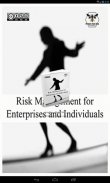




Risk Management

คำอธิบายของRisk Management
This textbook is designed to reflect the dynamic nature of the field of risk management as an introduction to intermediate-level students. The catastrophes of the first decade of the new millennium, including the credit crisis of 2008–2009, are well depicted and used to illustrate the myriad of old and new risks of our times. With such major man-made and natural catastrophes, this field is of utmost importance for sustainability. The need to educate students to consider risks at every phase in a business undertaking is central, and this textbook provides such educational foundation.
This field requires timeliness as new risk management techniques and products are being developed in response to risks derived from innovations and sophistication. As such, this book allows the reader to be on the forefront of knowledge in the arena of risk management. Tomorrow’s leaders in business and politics and tomorrow’s citizens, consumers, and voters need to understand risks to make successful decisions. This book provides you with the background for doing so.
With the pedagogical enhancements and the ability to make changes dynamically, this textbook brings the best to educators. An important advantage of this book’s publication format is that it can be updated in real time online as new risks appear (e.g., pandemic risk, financial crisis, terrorist attacks). Risk management consequences can be discussed immediately.
The management of risk is, essentially, the strategy for surviving and thriving in a volatile, uncertain, complex, and ambiguous world. Prior to the industrial revolution and the advanced communication age, decisions could be made easily using heuristics or “gut level feel” based on past experience.
As long as the world faced by the decision maker was more or less the same as that faced yesterday, gut level decision making worked fairly well. The consequences of failure were concentrated in small locations. Entire villages were extinguished due to lack of crop risk planning or diseases. There were no systemic contagious interlocking risks, such as those that brought the financial markets to their knees worldwide in 2008–2009.
Saylor URL: http://www.saylor.org/books
Creative Commons Attribution-NonCommercial-ShareAlike 3.0 License
Project Fast Hub, http://www.projectfasthub.com
EPUB3Reader, V. Giacometti, M. Giuriato, B. Petrantuono
หนังสือเล่มนี้ถูกออกแบบมาเพื่อสะท้อนให้เห็นถึงลักษณะของเขตของการบริหารความเสี่ยงเป็นเบื้องต้นให้กับนักเรียนระดับกลาง หายนะของทศวรรษแรกของสหัสวรรษใหม่รวมทั้งวิกฤตสินเชื่อของปี 2008-2009 เป็นภาพที่ดีและนำมาใช้เพื่อแสดงให้เห็นถึงความเสี่ยงมากมายของทั้งเก่าและใหม่ของเราครั้ง กับที่มนุษย์สร้างขึ้นและเป็นธรรมชาติภัยพิบัติที่สำคัญเช่นข้อมูลนี้มีความสำคัญสูงสุดสำหรับการพัฒนาอย่างยั่งยืน จำเป็นที่จะต้องให้ความรู้แก่นักเรียนที่จะพิจารณาถึงความเสี่ยงในทุกขั้นตอนในการดำเนินธุรกิจเป็นศูนย์กลางและหนังสือเล่มนี้ให้มูลนิธิการศึกษาดังกล่าว.
ฟิลด์นี้ต้องทันเวลากับเทคนิคการบริหารความเสี่ยงและผลิตภัณฑ์ใหม่ที่มีการพัฒนาในการตอบสนองต่อความเสี่ยงที่มาจากนวัตกรรมและความซับซ้อน เช่นหนังสือเล่มนี้จะช่วยให้ผู้อ่านที่จะอยู่ในระดับแนวหน้าของความรู้ในเวทีของการบริหารความเสี่ยง ผู้นำของวันพรุ่งนี้ในธุรกิจและการเมืองและวันพรุ่งนี้ของประชาชนผู้บริโภคและผู้มีสิทธิเลือกตั้งจะต้องเข้าใจความเสี่ยงในการตัดสินใจที่ประสบความสำเร็จ หนังสือเล่มนี้จะช่วยให้คุณมีพื้นหลังสำหรับการทำเช่นนั้น.
ด้วยการปรับปรุงการเรียนการสอนและความสามารถในการเปลี่ยนแปลงแบบไดนามิกหนังสือเล่มนี้นำที่ดีที่สุดเพื่อการศึกษา ประโยชน์ที่สำคัญของรูปแบบสิ่งพิมพ์หนังสือเล่มนี้ก็คือว่ามันสามารถนำมาปรับปรุงในเวลาจริงออนไลน์เป็นความเสี่ยงใหม่ปรากฏขึ้น (เช่นความเสี่ยงระบาดวิกฤตการณ์ทางการเงิน, การโจมตีของผู้ก่อการร้าย) ผลกระทบการบริหารความเสี่ยงที่สามารถพูดคุยได้ทันที.
การบริหารจัดการความเสี่ยงเป็นหลักกลยุทธ์สำหรับการรอดตายและเจริญรุ่งเรืองในความผันผวนไม่แน่นอนซับซ้อนและคลุมเครือโลก ก่อนที่จะมีการปฏิวัติอุตสาหกรรมและยุคการสื่อสารที่ทันสมัยในการตัดสินใจอาจจะทำอย่างง่ายดายโดยใช้การวิเคราะห์พฤติกรรมหรือ "ระดับความรู้สึกลำไส้" ขึ้นอยู่กับประสบการณ์ที่ผ่านมา.
ตราบใดที่โลกต้องเผชิญกับการตัดสินใจได้มากขึ้นหรือน้อยลงเช่นเดียวกับที่ต้องเผชิญกับเมื่อวานนี้การตัดสินใจระดับลำไส้ทำงานค่อนข้างดี ผลที่ตามมาของความล้มเหลวมีความเข้มข้นในสถานที่เล็ก ๆ ทั้งหมู่บ้านดับเนื่องจากการขาดการวางแผนความเสี่ยงพืชหรือโรค ไม่มีความเสี่ยงโรคติดต่อประสานระบบเช่นผู้ที่นำตลาดการเงินไปที่หัวเข่าของพวกเขาทั่วโลกใน 2008-2009.

























